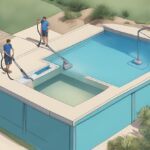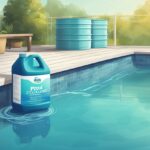When considering the cleanliness and clarity of your pool water, a diatomaceous earth (D.E.) filter can be an efficient solution compared with other filtering options. A D.E. filter uses a natural substance called diatomaceous earth to trap particles as small as 1 to 6 microns, providing superior filtration. Tiny particles, such as dirt, algae, and skin flakes that would normally pass through sand or cartridge filters, are caught within the D.E. powder that coats the filter grids.

D.E. filters require more attention in terms of maintenance and may carry a higher initial cost, but the investment could lead to a cleaner pool environment. Regular cleaning and replenishment of the D.E. powder are necessary to maintain the filter’s effectiveness. When considering a pool filtration system, it’s important to weigh the long-term benefits of excellent water quality against the higher degree of upkeep that a D.E. filter demands.
Fundamentals of DE Filtration
In your pool maintenance, understanding how a Diatomaceous Earth (DE) filter system functions is crucial to achieving crystal clear water. This system provides superior filtration by trapping particles as small as a few microns.
Understanding Diatomaceous Earth
Diatomaceous Earth (DE) is a natural substance composed of the fossilised remains of diatoms, which are microscopic algae with silica-based cell walls. When used in pool filtration, DE acts as a fine, porous powder that attaches to the filter grids, creating a filter media to capture tiny particles from your pool water.
-
Particle Size: DE filters are capable of trapping particles down to 3-5 microns in size, including dust, dirt, algae, and even some forms of bacteria that might be present in your pool water.
-
Effectiveness: Due to this fine filtration capacity, DE filtration is known to leave water exceptionally clean and is often considered more effective than traditional sand or cartridge filters.
Components of a DE Filter System
A DE filter system consists of various key components that work together to ensure the cleanliness of your pool water:
- Filter Grids: These are coated with DE powder and are the primary component where the actual filtration occurs.
- Manifold: Holds the grids in position and allows uniform water flow through the filter.
- Pressure Plates: Help to maintain the structure of the grids and prevent deformation under pressure.
- Gasket: Seals the filter tank to prevent leaks.
- Inlet/Outlet: Water flows into the DE filter, passes through the powder-covered grids where debris is captured, and exits back into the pool.
To clean the filter, a backwash procedure is required, which involves reversing the water flow to remove the trapped debris from the DE powder on the grids. This means periodically replenishing the DE to maintain filtration effectiveness. Regular maintenance ensures your DE filter system operates at peak efficiency, making it a highly reliable choice for your pool.
DE Filters Versus Other Pool Filters
In assessing pool filtration systems, you’ll find that DE filters often provide superior water clarity but come with their own set of maintenance requirements and initial costs. Your pool’s cleanliness, the frequency of filter maintenance, and the investment you’re willing to make upfront can all help determine the best filter for you.
DE versus Sand Filters
Debris Filtration: DE filters are capable of trapping particles as small as 3-5 microns, whereas sand filters catch particles between 20-40 microns. This means that DE filters can prevent finer particles, such as skin flakes and dust, from re-entering your pool, providing clearer water.
- Maintenance & Cleaning: With a DE filter, you’ll engage in more frequent cleaning cycles known as “backwashing,” which removes debris from the filter. Sand filters require less frequent backwashing but generally hold onto larger waste particles.
- Energy Costs: Given that DE filters can maintain cleaner water at lower pump speeds, your energy costs may be reduced when compared to sand filters, which sometimes necessitate higher pump speeds for effective filtration.
DE versus Cartridge Filters
Filter Media: A DE filter uses diatomaceous earth powder as its filter media, which attaches to grids within the filter tank, capturing microscopic debris. Cartridge filters use a pleated fabric material to screen out particles and don’t require DE powder.
- Maintenance & Replacement: Cartridge filters are often seen as less labor-intensive since they don’t need backwashing and can be simply hosed off. However, they may require more frequent replacement than DE filter media, impacting long-term costs.
- Pressure Gauge Monitoring: For both DE and cartridge filters, it’s vital to monitor the pressure gauge. A significant rise indicates cleaning is due; however, DE filters typically experience a quicker pressure increase, signalling the need for more regular maintenance.
Both options have different implications on maintenance practices, costs, and overall water clarity in your pool. Your choice will affect how often you’ll be checking the pressure gauge, cleaning the filter media, and investing in energy costs or replacement parts.
Operating a DE Filter
In the context of pool maintenance, operating a DE (Diatomaceous Earth) filter involves a specific set of procedures, including the backwashing process, adding and replacing DE powder, and conducting regular maintenance to ensure optimal function and cleanliness of your pool water.
The Backwashing Process
When your pool’s water flow becomes sluggish, or the pressure gauge indicates a rise in pressure, it’s time to backwash your DE filter. Backwashing reverses the water flow, flushing out trapped dirt and debris from the filter grids. Here’s how you do it:
- Turn off the pool pump to halt water flow.
- Set the valve to the ‘backwash’ position.
- Restart the pump and let the water run until it appears clear in the sight glass, usually about 2-3 minutes.
- Shut off the pump again, return the valve to its ‘filter’ position, and resume normal operation.
Remember to check your pool’s water chemistry after backwashing, as this process can alter it.
Adding and Replacing DE Powder
After backwashing, DE powder will need to be replenished to maintain filter efficiency:
- Measure the correct amount of DE powder according to your filter’s size and manufacturer’s instructions.
- Add the DE powder to the skimmer, with the pool pump running, to allow it to distribute evenly across the filter grids.
Regularly inspect the grids or replacement cartridges for signs of wear or damage, which can decrease filtering efficiency. Include the replacement of these components as part of your DE filter’s maintenance routine.
Regular Maintenance
To keep your DE filter functioning correctly, it’s crucial to establish a maintenance routine:
- Inspect the filter grids or cartridges frequently for tears or degradation.
- Clean the grids or cartridges thoroughly at least once a year using a garden hose, or more often if heavily used.
- Maintain balanced water chemistry to prevent issues with your filter and ensure its longevity.
By following these guidelines and performing consistent maintenance, your DE Filter should provide superior filtration with relatively low maintenance demands compared to alternatives.
Choosing the Right DE Filter

When selecting a D.E. (Diatomaceous Earth) filter for your swimming pool, it’s essential to consider both its size and cost in relation to your pool’s requirements and the ongoing expense of operation. Understanding the advantages and disadvantages will also help you make an informed decision for both inground and above ground pools.
Sizing and Cost Considerations
The size of your pool is the primary determinant of the filter size you’ll need; a larger pool will require a higher capacity filter. Ensure your pool pump can effectively circulate water through the D.E. filter, as inadequate flow will reduce the filter’s efficiency.
- Inground Pools: Opt for a high-capacity filter, such as the Hayward ProGrid D.E. Filter, to accommodate the larger volumes of water.
- Above Ground Pools: A smaller filter like the Hayward Perflex D.E. Filter is typically sufficient due to the lower water volume.
Initial cost outlay for a D.E. filter can be higher than other filter types. However, consider the potential cost savings on energy and water when evaluating the total cost. D.E. filters can lead to lower energy costs due to more efficient water filtration requiring less frequent cycling of the pool pump.
Advantages and Disadvantages
Advantages:
- Superior filtration: Capable of filtering out particles down to 5 microns, providing you with clearer pool water than sand or cartridge filters.
- Energy efficiency: As they often require less frequent backwashing, they can save water and energy costs over time.
Disadvantages:
- Higher initial cost: D.E. filters can be more expensive upfront when compared to sand or cartridge filters.
- Maintenance: They require periodic backwashing and the D.E. powder must be replenished, which can be more involved than maintenance for other types of filters.
Consider the space you have for the filter as well; D.E. filters can be bulkier, and real estate in smaller spaces might be limited. Despite this, the improved water clarity and potential cost savings make D.E. filters a compelling option for many pool owners.











